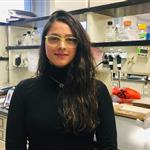Advanced Search
Isolation and Efficient Maize Protoplast Transformation
Published: Aug 20, 2019 DOI: 10.21769/BioProtoc.3346 Views: 6555
Edited by: Marisa Rosa Reviewed by: Yan Bao
Abstract
Establishing plant gene function and the study of gene expression regulation often require that genes (or gene variants) are introduced into plants and their activity somehow assayed. Some plants (e.g., Arabidopsis) are easily transformed, while for others (e.g., maize) making stable transgenic plants remains challenging, is expensive and time-consuming. An alternative solution to generating transgenic plants is to assay gene function transiently. In some plants, it is possible to do this by Agro-infiltration. We have adapted a maize protoplast isolation protocol that permits high-efficiency transformation by electroporation, irrespective of the genetic background. Transformed protoplasts have been used to assay gene function using metabolic profiling, to explore protein-DNA interactions using chromatin immunoprecipitation (ChIP), and to assay the activation of reporter constructs by transcription factors. Here, we describe the protocol for efficient maize protoplast isolation and transformation by electroporation.
Keywords: MaizeBackground
Maize (Zea mays) is one of the most cultivated crops in the world, with a productivity that continues to increase thanks to genetic advances and to improved agronomic practices (Haarhoff and Swanepoel, 2018). In addition to the grain, the stover is used for the production of biofuels and electricity (Trivedi et al., 2015). Maize is also an important model plant for fundamental research (Cone et al., 2002; Nannas and Dawe, 2015). While a large number of maize genes have been cloned and characterized, functional information on many genes is still lacking (Jin et al., 2017; Cao et al., 2018). One of the strategies most commonly used to determine gene function is the characterization of the phenotypes of loss-of-function mutants. Unless multiple alleles are available, the usual practice is to complement the mutants with the wild-type gene to confirm the nature of the mutation. When multiple candidate genes must be validated, in a plant like maize, this can become prohibitively expensive and very time-consuming. In some instances, for example, to identify the gene responsible for a missing step in a biosynthetic pathway, transformation of protoplasts derived from the mutant with the candidate genes, combined if necessary with precursor feeding, can narrow down, or even identify, the responsible gene (Casas et al., 2016). We have also successfully used maize protoplast transformation to confirm transcription factor target genes (Yang et al., 2017), and to establish the organization of transcriptional complexes (Hernandez et al., 2007). We describe here a fast and simple protocol to generate and transform protoplasts from maize seedlings, irrespective of the genotype. This protocol is largely based on Sheen (1991 and 2001) and Jang and Sheen (1994).
Materials and Reagents
- Pipette tips (Fisher brand, catalog number: 02707414)
- Aluminum foil (Reynolds Kitchens, REYNOLDS WRAP, catalog number: 353224)
- Filter paper (Fisher Scientific, catalog number: 34155)
- Parafilm (Fisher Scientific, catalog number: 13-374-12)
- 35 μm Mesh (Carolina biological supplies, catalog number: 652222R)
- Single Edge Blade 009 (Accutec blades, catalog number: 94-0491-0000)
- Glass cutting board
- Electroporation Cuvettes (BIO-RAD, catalog number: 1652088)
- 50 ml Falcon tubes (Thermo Fisher, catalog number: 14-432-22)
- 1.7 ml Microcentrifuge tubes (Fisher Scientific, catalog number: 21-402-905)
- 25 seeds of maize
- Cellulase “ONOZUKA” RS (Yakult Pharmaceutical Industry Co., Ltd)
- Macerozyme R-10 (Yakult Pharmaceutical Industry Co., Ltd)
- D-Mannitol (Fisher Scientific, catalog number: M120-3)
- Potassium Chloride (KCl) (Sigma-Aldrich, catalog number: P3911)
- MES free acid monohydrate (GoldBIO, catalog number: M-090-500)
- Calcium chloride (CaCl2) (Sigma-Aldrich, catalog number: C2661).
- Bovine serum albumin (BSA) (Sigma-Aldrich, catalog number: A3059)
- Maxiprep Kit (Invitrogen, catalog number: K210017)
- Protoplasts buffer (see Recipes)
- Enzyme suspension (see Recipes)
Equipment
- Flask with side arm
- Pipettes
- Hemocytometer (Hausser & Son LEVY ULTRA PLANE Improved NEUBAUER MINT)
- Centrifuge (Thermo ScientificTM SorvallTM LegendTM XTR)
- Electroporator (BTX electro-square-Porator ECM 830)
- Fluorescence microscope (Leica DM IL LED Inverted Phase Contrast Microscope with the camera Leica DFC 3000 G)
- Optical microscope (Reichert Scientific Jung microscope series 150)
- Refrigerated incubator (Fisher Scientific, catalog number: 3720A)
- Benchtop Orbital Shakers (Fisher Scientific, catalog number: SHKE3000)
- Microcentrifuge (Thermo Scientific, model: SorvallTM LegendTM Micro 17, catalog number: 75002403)
- Water bath (VWR, model: 1230)
Procedure
Category
Plant Science > Plant transformation > Electroporation
Cell Biology > Cell isolation and culture > Transformation
Do you have any questions about this protocol?
Post your question to gather feedback from the community. We will also invite the authors of this article to respond.
Share
Bluesky
X
Copy link

